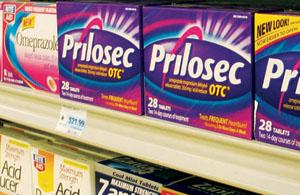Two new OTC proton-pump inhibitors may bring Rx users to OTC side of pharmacies
By the end of the year, two new proton-pump inhibitor products will likely line store shelves alongside Procter & Gamble’s Prilosec OTC—Schering-Plough’s Zegerid and Novartis’ Prevacid 24HR—and that ought to generate some heated market-share battles around over-the-counter PPIs.
All of this new product activity could mean some pretty substantial incremental growth, especially as the two proposed switch PPIs possibly would bring loyal prescription users back to the nonprescription side of the pharmacy counter.
“Prevacid, because it has a big Rx following, that’s definitely going to bring incremental sales,” said Laura Mahecha, industry manager of healthcare practice for market research firm Kline. “Zegerid, to some extent, might bring some Rx users, but it doesn’t have near as large a following in the Rx market as Prevacid,” she added, suggesting the Zegerid launch may grab share from Prilosec OTC, omeprazole store brand and Prevacid 24HR, and even some of the older acid relievers, such as Tums, Pepcid and Zantac, given the brand’s potential point-of-difference as a fast-acting PPI.
One thing is for sure, however: Consumers are going to be getting plenty of messaging around heartburn relief this year, which ought to translate into an increase in foot traffic walking past the digestives aisles. “Overall, the category, with the switches of Prevacid and Zegerid,…will grow pretty significantly over the next five years,” Mahecha said, predicting that category growth may run in the 5% to 6% range over that period.
And that growth is not likely to slow down; the patent protecting Wyeth’s Protonix PPI expires in July 2010, making it another possible PPI switch candidate, Mahecha noted.
Currently, sales of antacid tablets stand at $1.1 billion across food, drug and mass (minus Walmart) for the 52 weeks ended April 19, according to Information Resources Inc. The category is slightly down by 1.3%, though that may be attributed in large part to the addition of Prilosec OTC store-brand equivalents in March 2008.
Prilosec OTC sales fell 24.8% to $289.5 million in the period, while lower-dollar-generating private label for the entire category grew 75.6% to $266.1 million. “Clearly, Prilosec, which we built into a phenomenal brand and is still a very strong brand, is now going through the phase where the generics are going to be introduced, and we know we’re going to lose some of that business,” said P&G chairman and CEO A.G. Lafley during a recent conference call. “The key is how much of it do we hold on to, and how do we sustain it?”
The store brand version of omeprazole OTC is capturing nearly 40% of the market, noted Perrigo’s chairman and CEO Joe Papa last month. “Recent sales data shows that we are on track to reach the high end of our original annual sales guidance range of $150 million to $200 million.”
In addition to store-brand competition, marketers at P&G may soon be contending with two PPI branded competitors.
Schering-Plough is expected to tout two significant points of differentiation between Zegerid (omeprazole/sodium bicarbonate) and other delayed-release PPIs. For starters, the sodium bicarbonate serves as a buffer to protect the active ingredient omeprazole, allowing for an immediate-release formulation that begins working in about 30 minutes. Conversely, the other approved-for-sale OTC PPI products could take as long as two to three hours before providing symptomatic relief. Zegerid also has been proven to help control nighttime relief better as compared with the other prescription PPIs, such as Nexium (esomeprazole) and Prevacid (lansoprazole), though the tutorial on zegerid.com acknowledges that correlation of the pharmacodynamic data establishing that “better” relief to clinical effect has not been established.
Those could be two significant points of differentiation if, in fact, Schering’s switch application proves successful. In January, the Food and Drug Administration issued the company a Complete Response Letter (the new, undiscriminating system replaces the approvable and not approvable letters), suggesting that the FDA still had questions regarding the Zegerid switch.
However, because the FDA no longer indicates the direction in which the agency is leaning on any given drug application, it is not known definitively whether Zegerid will reach shelves this year. Incidentally, each of the active ingredients in Zegerid are approved for sale OTC as single-ingredient products, and both to help alleviate symptoms of heartburn.
Executives at Santarus, from which Schering-Plough secured the OTC rights for Zegerid, are optimistic in suggesting that the FDA may be leaning more toward “approvable” than “not approvable.”
“Santarus believes that the response will be based on further analysis of existing data,” Gerald Proehl, Santarus president and CEO, told analysts in March. “While we can’t predict with certainty what the FDA will require, if the analysis of the existing data is acceptable to the FDA, Santarus does not believe there will be a need for any additional clinical study.” In a conference call last month, Santarus executives noted that a $20 million milestone payment for an approved OTC Zegerid was still a possibility for 2009.
Prevacid 24HR, on the other hand, has been approved for sale OTC, though a firm launch date has yet to be announced by Novartis Consumer Healthcare. The second PPI to reach store shelves is likely to make its debut just in time to help relieve holiday heartburn in November, which is when the prescription patent expires. Prevacid 24HR will enjoy patent exclusivity for the ensuing three years.
Prevailing theory holds that switched products hold onto a good portion of existing prescription patients. However, that may only apply to first-in-class switches. Last year, Wolters Kluwer Health and The Nielsen Co. followed McNeil Consumer Healthcare’s switch of Zyrtec, the second second-generation antihistamine to reach the market, finding that a full 84% of those who switched to Zyrtec OTC weren’t former Zyrtec prescription users, but former Claritin and Benadryl users. That suggests a lower carryover from the base of prescription users.


